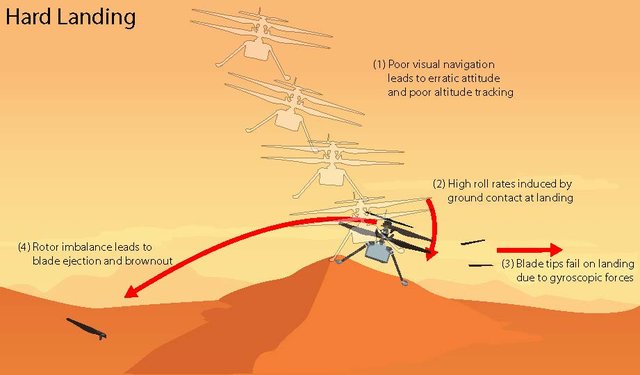
NASA’s Ingenuity Mars Helicopter Team Says Goodbye … for Now
Engineers working on NASA’s Ingenuity Mars Helicopter assembled for one last time in a control room at the agency’s Jet Propulsion Laboratory in Southern California on Tuesday, April 16, to monitor a transmission from the history-making helicopter. While the mission ended Jan. 25, the rotorcraft has remained in communication with the agency’s Perseverance Mars rover, which serves as a base station for Ingenuity. This transmission, received through the antennas of NASA’s Deep Space Network, marked the final time the mission team would be working together on Ingenuity operations.
Now the helicopter is ready for its final act: to serve as a stationary testbed, collecting data that could benefit future explorers of the Red Planet.
“With apologies to Dylan Thomas, Ingenuity will not be going gently into that good Martian night,” said Josh Anderson, Ingenuity team lead at JPL. “It is almost unbelievable that after over 1,000 Martian days on the surface, 72 flights, and one rough landing, she still has something to give. And thanks to the dedication of this amazing team, not only did Ingenuity overachieve beyond our wildest dreams, but also it may teach us new lessons in the years to come.”
Originally designed as a short-lived technology demonstration mission that would perform up to five experimental test flights over 30 days, the first aircraft on another world operated from the Martian surface for almost three years, flew more than 14 times farther than the distance expected, and logged more than two hours of total flight time.
Ingenuity’s mission ended after the helicopter experienced a hard landing on its last flight, significantly damaging its rotor blades. Unable to fly, the rotorcraft will remain at “Valinor Hills” while the Perseverance rover drives out of communications range as it continues to explore the western limb of Jezero Crater.
Bytes and Cake
The team enjoyed some “Final Comms” chocolate cake while reviewing the latest data from over 189 million miles (304 million kilometers) away. The telemetry confirmed that a software update previously beamed up to Ingenuity was operating as expected. The new software contains commands that direct the helicopter to continue collecting data well after communications with the rover have ceased.

Engineers working on NASA’s Ingenuity together monitored a transmission from the history-making helicopter in a JPL control room on April 16. They confirmed the operation of a software patch that will allow the helicopter to act as a stationary testbed and collect data that could benefit future Mars explorers.
Credit: NASA/JPL-Caltech
With the software patch in place, Ingenuity will now wake up daily, activate its flight computers, and test the performance of its solar panel, batteries, and electronic equipment. In addition, the helicopter will take a picture of the surface with its color camera and collect temperature data from sensors placed throughout the rotorcraft. Ingenuity’s engineers and Mars scientists believe such long-term data collection could not only benefit future designers of aircraft and other vehicles for the Red Planet, but also provide a long-term perspective on Martian weather patterns and dust movement.
During this final gathering, the team received a farewell message from Ingenuity featuring the names of people who worked on the mission. Mission controllers at JPL sent the message to Perseverance the day before, which handed it off to Ingenuity so that it could transmit the farewell back to Earth.
Decades of Room
If a critical electrical component on Ingenuity were to fail in the future, causing data collection to stop, or if the helicopter eventually loses power because of dust accumulation on its solar panel, whatever information Ingenuity has collected will remain stored on board. The team has calculated Ingenuity’s memory could potentially hold about 20 years’ worth of daily data.
“Whenever humanity revisits Valinor Hills — either with a rover, a new aircraft, or future astronauts — Ingenuity will be waiting with her last gift of data, a final testament to the reason we dare mighty things,” said Ingenuity’s project manager, Teddy Tzanetos of JPL. “Thank you, Ingenuity, for inspiring a small group of people to overcome seemingly insurmountable odds at the frontiers of space.”
Tzanetos and other Ingenuity alumni are currently researching how future Mars helicopters — including the Mars Science Helicopter concept — could benefit explorations of the Red Planet and beyond.
More About the Mission
The Ingenuity Mars Helicopter was built by JPL, which also manages the project for NASA Headquarters. It is supported by NASA’s Science Mission Directorate. NASA’s Ames Research Center in California’s Silicon Valley and NASA’s Langley Research Center in Hampton, Virginia, provided significant flight performance analysis and technical assistance during Ingenuity’s development. AeroVironment Inc., Qualcomm, and SolAero also provided design assistance and major vehicle components. Lockheed Space designed and manufactured the Mars Helicopter Delivery System. At NASA Headquarters, Dave Lavery is the program executive for the Ingenuity Mars helicopter.
For more information about Ingenuity:
https://mars.nasa.gov/technology/helicopter
Recommend0 recommendationsPublished in Marstronaut



